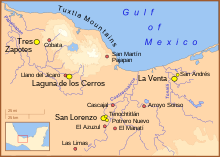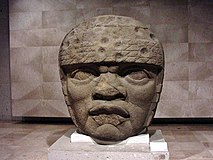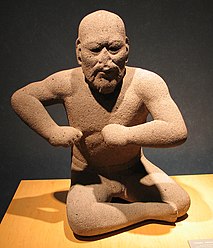 The Olmec heartland, where the Olmec reigned from 1200 to 400 BCE | |
| Geographical range | Veracruz, Mexico |
|---|---|
| Period | Preclassic Era |
| Dates | c. 1200 – 400 BCE |
| Type site | San Lorenzo Tenochtitlán |
| Major sites | La Venta, Tres Zapotes, Laguna de los Cerros |
| Preceded by | Archaic Mesoamerica |
| Followed by | Epi-Olmecs |
The Olmecs (/ˈɒlmɛks, ˈoʊl-/) were the earliest known major Mesoamerican civilization, flourishing in the modern-day Mexican states of Veracruz and Tabasco from roughly 1200 to 400 BCE during Mesoamerica's formative period. They were initially centered at the site of their development in San Lorenzo Tenochtitlán, but moved to La Venta in the 10th century BCE following the decline of San Lorenzo.[1] The Olmecs disappeared mysteriously in the 4th century BCE, leaving the region sparsely populated until the 19th century.
Among other "firsts", the Olmec appeared to practice ritual bloodletting and played the Mesoamerican ballgame, hallmarks of nearly all subsequent Mesoamerican societies. The aspect of the Olmecs most familiar now is their artwork, particularly the colossal heads.[2] The Olmec civilization was first defined through artifacts which collectors purchased on the pre-Columbian art market in the late 19th and early 20th centuries. Olmec artworks are considered among ancient America's most striking.[3]
- ^ Diehl, Richard A. (2004). The Olmecs : America's First Civilization. London: Thames and Hudson. pp. 9–25. ISBN 0-500-28503-9.
- ^ See, as one example, Diehl, p. 11.
- ^ See Diehl, p. 108 for the "ancient America" superlatives. The artist and archaeologist Miguel Covarrubias (1957) p. 50 says that Olmec pieces are among the world's masterpieces


